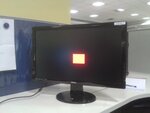sukanya28
Junior Member level 2
Hi, I wish to display a red square through my verilog code but a bar is getting displayed, also I am not able to change my right co-ordinate. Why is it so?? Please help !!
Code :
Code :
Code:
module vga_sq(input wire clk,reset,
output wire hsync,vsync,
output [2:0] red, // three bit signal to drive color red
output [2:0] green, // three bit signal to drive color green
output [1:0] blue, // two bit signal to drive color blue (human eye is less sensitive to color blue)
output reg video_on);
// defining constants
localparam HD = 800; // horizontal display area
localparam HF = 56; // front porch (right border)
localparam HB = 64; //right porch (left border)
localparam HR = 120; // horizontal retrace
localparam VD = 600; // vertical display area
localparam VF = 37; // front porch (bottom border)
localparam VB = 23; // back porch (top border)
localparam VR = 6; // vertical retrace
localparam h_end = 1040; // total horizontal timing
localparam v_end = 666; // total vertical timing
//localparam sq_size = 20; // size of square
localparam sq_x_l = 390; // left coordinate of square
localparam sq_x_r = 410;
localparam sq_y_t = 290;
localparam sq_y_b = 400;
//horizontal and vertical counter
reg [10:0] h_count_reg,v_count_reg ; // registers for sequential horizontal and vertical counters
reg[10:0] h_count_next , v_count_next;
//reg v_sync_reg , h_sync_reg ;
//wire v_sync_next , h_sync_next ;
reg v_sync_next , h_sync_next = 0 ;
always @ ( posedge clk , posedge reset)
if (reset)
begin
v_count_reg <= 0;
h_count_reg <= 0 ;
//v_sync_reg <= 1'b0;
//h_sync_reg <= 1'b0;
end
else
begin
v_count_reg <= v_count_next;
h_count_reg <= h_count_next;
//v_sync_reg <= v_sync_next ;
//h_sync_reg <= h_sync_next ;
end
// horizontal and vertical counters
always @(posedge clk)
begin
if(h_count_next < h_end-1)
begin
h_count_next <= h_count_next + 1;
end
else
begin
h_count_next <= 0;
if(v_count_next < v_end-1)
v_count_next <= v_count_next + 1;
else
v_count_next <= 0;
end
end
// horizontal and vertical synchronization signals
always @(posedge clk)
if(h_count_reg < HR)
h_sync_next <= 1;
else
h_sync_next <= 0;
//VSync logic
always @(posedge clk)
if(v_count_reg < VR)
v_sync_next <= 1;
else
v_sync_next <= 0;
assign hsync = h_sync_next;
assign vsync = v_sync_next;
reg h_video_on,v_video_on; // these registers ensure that the display signals are sent only when the pixels are within the display region of the monitor.
//horizontal logic
always @(posedge clk)
if((h_count_reg >= HR + HF) && (h_count_reg< HR + HF + HD))
h_video_on <= 1;
else
h_video_on <= 0;
//Vertical logic
always @(posedge clk)
if((v_count_reg >= VR + VF) && (v_count_reg < VR + VF+ VD))
v_video_on <= 1;
else
v_video_on <= 0;
always @(posedge clk)
if(h_video_on && v_video_on)
video_on <= 1;
else
video_on <= 0;
reg [9:0] pixel_x,pixel_y; // registers to describe current position of pixel within display area.
always @(posedge clk)
if(h_video_on)
pixel_x <= h_count_reg - HR - HF;
else
pixel_x <= 0;
always @(posedge clk)
if(v_video_on)
pixel_y <= v_count_reg - VR - VF;
else
pixel_y <= 0;
//color output
reg [7:0] coloroutput; // 8 bit register which describes which color has to be displayed but only when video_on signal is turned on.
always @(posedge clk)
if(~video_on)
coloroutput <= 0;
else
begin
if((pixel_x > sq_x_l && pixel_x < sq_x_r) && (pixel_y > sq_y_t && pixel_y < sq_y_b ))
coloroutput[7:5] <= 3'b111;
else
coloroutput [4:0] <= 5'b00000;
end
assign red = coloroutput[7:5];
assign green = coloroutput[4:2] ;
assign blue = coloroutput[1:0] ;
endmodule